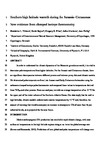Southern high-latitude warmth during the Jurassic–Cretaceous: New evidence from clumped isotope thermometry
| dc.contributor.author | Vickers, ML | |
| dc.contributor.author | Bajnai, D | |
| dc.contributor.author | Price, GD | |
| dc.contributor.author | Linckens, J | |
| dc.contributor.author | Fiebig, J | |
| dc.date.accessioned | 2019-06-24T11:49:44Z | |
| dc.date.available | 2019-06-24T11:49:44Z | |
| dc.date.issued | 2019-05-31 | |
| dc.identifier.issn | 0091-7613 | |
| dc.identifier.issn | 1943-2682 | |
| dc.identifier.uri | http://hdl.handle.net/10026.1/14389 | |
| dc.description.abstract |
<jats:title>Abstract</jats:title> <jats:p>In order to understand the climate dynamics of the Mesozoic greenhouse world, it is vital to determine paleotemperatures from higher latitudes. For the Jurassic and Cretaceous climate, there are significant discrepancies between different proxies and between proxy data and climate models. We determined paleotemperatures from Late Jurassic and Early Cretaceous belemnites using the carbonate clumped isotope paleothermometer and compared these values to temperatures derived from TEX86 and other proxies. From our analyses, we infer an average temperature of ∼25 °C for the upper part of the water column of the southern Atlantic Ocean. Our data imply that for mid- to high latitudes, climate models underestimate marine temperatures by >5 °C and, therefore, the amount of warming that would accompany an increase in atmospheric CO2 of more than 4× pre-industrial levels, as is projected for the near future.</jats:p> | |
| dc.format.extent | 724-728 | |
| dc.language | en | |
| dc.language.iso | en | |
| dc.publisher | Geological Society of America | |
| dc.subject | 37 Earth Sciences | |
| dc.subject | 3709 Physical Geography and Environmental Geoscience | |
| dc.subject | 3702 Climate Change Science | |
| dc.subject | 3705 Geology | |
| dc.subject | 13 Climate Action | |
| dc.title | Southern high-latitude warmth during the Jurassic–Cretaceous: New evidence from clumped isotope thermometry | |
| dc.type | journal-article | |
| dc.type | Article | |
| plymouth.author-url | https://www.webofscience.com/api/gateway?GWVersion=2&SrcApp=PARTNER_APP&SrcAuth=LinksAMR&KeyUT=WOS:000476707800016&DestLinkType=FullRecord&DestApp=ALL_WOS&UsrCustomerID=11bb513d99f797142bcfeffcc58ea008 | |
| plymouth.issue | 8 | |
| plymouth.volume | 47 | |
| plymouth.publication-status | Published | |
| plymouth.journal | Geology | |
| dc.identifier.doi | 10.1130/g46263.1 | |
| plymouth.organisational-group | /Plymouth | |
| plymouth.organisational-group | /Plymouth/Faculty of Science and Engineering | |
| plymouth.organisational-group | /Plymouth/Faculty of Science and Engineering/School of Geography, Earth and Environmental Sciences | |
| plymouth.organisational-group | /Plymouth/REF 2021 Researchers by UoA | |
| plymouth.organisational-group | /Plymouth/REF 2021 Researchers by UoA/UoA07 Earth Systems and Environmental Sciences | |
| plymouth.organisational-group | /Plymouth/Research Groups | |
| plymouth.organisational-group | /Plymouth/Research Groups/Marine Institute | |
| plymouth.organisational-group | /Plymouth/Users by role | |
| plymouth.organisational-group | /Plymouth/Users by role/Academics | |
| plymouth.organisational-group | /Plymouth/Users by role/Researchers in ResearchFish submission | |
| dcterms.dateAccepted | 2019-05-08 | |
| dc.rights.embargodate | 2020-5-30 | |
| dc.identifier.eissn | 1943-2682 | |
| dc.rights.embargoperiod | Not known | |
| rioxxterms.versionofrecord | 10.1130/g46263.1 | |
| rioxxterms.licenseref.uri | http://www.rioxx.net/licenses/all-rights-reserved | |
| rioxxterms.licenseref.startdate | 2019-05-31 | |
| rioxxterms.type | Journal Article/Review | |
| plymouth.funder | Carbonate clumped-isotopic constraints on marine temperatures during the Cretaceous::NERC |


